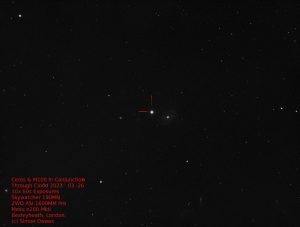On the night of the 26th/27th March 2023 Ceres appeared to ‘meet’ and pass directly in front of the beautiful spiral galaxy Messier 100 (M100) and for a few hours Ceres looked like a brilliant supernova beaming from one of the M100 galaxy’s arms.
At the time of the line-of-sight view, Ceres was shining from a piddling distance of 150 million miles (240 million kilometers) from Earth whilst the galaxy at 56 million light-years away; so actually trillions of miles apart! The ‘meeting’ took place in the constellation Coma Berenices just a few days after Ceres’ opposition, which is when Earth passes between it and the Sun.
Despite the poor weather CMHASD Trustee & member Simon Dawes managed to capture the event – see his image below 🙂 Ceres is identified with 2 red lines and M100 is at the 4 O’clock position from Ceres.
Ceres is a dwarf planet and the largest asteroid in the main asteroid belt that is between Mars & Jupiter. It was the first asteroid to be discovered on the 1st January 1801 and was classified as 1 Ceres in 1851. Ceres was designated a dwarf planet, a new category of solar system objects defined in August 2006 by the International Astronomical Union.
Ceres’s small size; about 14 times smaller than Pluto means that even at its brightest, it is too dim to be seen by the naked eye, except under extremely dark skies. Its apparent magnitude ranges from 6.7 to 9.3, peaking at opposition.
Messier 100 (also known as NGC 4321) is a face-on, spiral galaxy with an apparent magnitude of 9.3. It is one of the brightest and largest galaxies with a diameter of 160,000 light years. It was discovered in 1781.
Information of how Simon acquired his image is on his photo and for more information about this event see https://skyandtelescope.org/astronomy-news/observing-news/tell-time-with-the-big-dipper-see-ceres-transit-m100/#:~:text=By%20good%20fortune%20Ceres%20will%20pass%20directly%20in,northern%20portion%20of%20the%20Virgo%20Cluster%20this%20spring.

